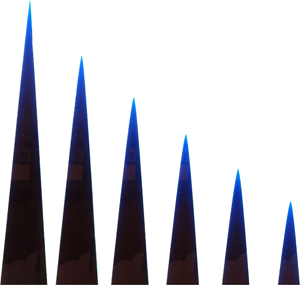Article contents
Shaping of melting and dissolving solids under natural convection
Published online by Cambridge University Press: 13 August 2020
Abstract

How quickly does an ice cube melt or a lump of sugar dissolve? We address the open problem of the shapes of solids left to melt or dissolve in an ambient fluid driven by stable natural convection. The theory forms a convective form of a Stefan problem in which the evolution is controlled by a two-way coupling between the shape of the body and stable convection along its surface. We develop a new model describing the evolution of such bodies in two-dimensional or axisymmetric geometries and analyse it using a combination of numerical and analytical methods. Different initial conditions are found to lead to different fundamental shapes and descent rates. For the cases of initially linear surfaces (wedges or cones), the model admits similarity solutions in which the tip descends from its initial position as  $t^{4/5}$, where t is time. It is determined that the evolving shape always forms a parabola sufficiently near the tip. For steeply inclined bodies, we establish a general two-tiered asymptotic structure comprising a broad
$t^{4/5}$, where t is time. It is determined that the evolving shape always forms a parabola sufficiently near the tip. For steeply inclined bodies, we establish a general two-tiered asymptotic structure comprising a broad  $4/3$-power intermediate near-tip region connected to a deeper parabolic region at the finest scale. The model results apply universally for any given relationship between density, viscosity, diffusivity and concentration, including two-component convection. New laboratory experiments involving the dissolution of cones of sugar candy in water are found to collapse systematically onto our theoretically predicted shapes and descent rates with no adjustable parameters.
$4/3$-power intermediate near-tip region connected to a deeper parabolic region at the finest scale. The model results apply universally for any given relationship between density, viscosity, diffusivity and concentration, including two-component convection. New laboratory experiments involving the dissolution of cones of sugar candy in water are found to collapse systematically onto our theoretically predicted shapes and descent rates with no adjustable parameters.
JFM classification
- Type
- JFM Papers
- Information
- Copyright
- © The Author(s), 2020. Published by Cambridge University Press
References
REFERENCES
- 10
- Cited by




